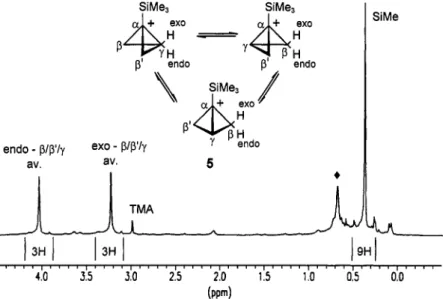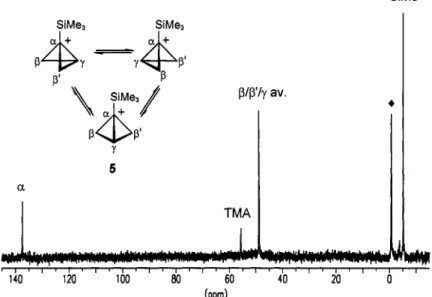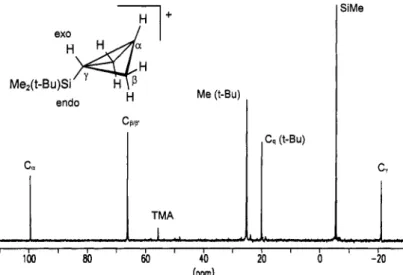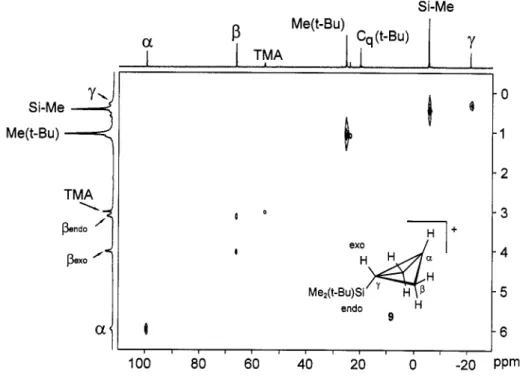Pure & Appl. Chern., Vol. 70, No. 10, pp. 2015-2022, 1998.
Printed in Great Britain.
0 1998 IUPAC
Recent advances in the experimental and
computational characterization of carbocations:
Silyl effects in bicyclobutonium ions
Hans-Ullrich Siehl*, Martin Fulj Abteilung fiir Organische Chemie I Universitat Ulm
D-89069 Ulm, Germany
E-mail: ullrich.siehl@chemie.uni-ulm,de FAX.: +49 (731) 502-2800
Abstract: Two trialkylsilyl substituted bicyclobutonium ion were investigated by NMR spectroscopy in superacid solution and by quantum chemical ab initio calculations. The 1- (trimethylsily1)bicyclobutonium ion undergoes a threefold degenerate methylene
rearrangement. The 3-endo-(tert-butyldimethylsilyl)bicyclobutonium ion is the first static bicyclobutonium ion. The NMR-spectra of this carbocation are a direct proof for the hypercoordinated and puckered structure of bicyclobutonium ions.
INTRODUCTION
Cyclobutyl cations (1) are intermediates in solvolysis reactions of cyclopropylmethyl and cyclobutyl halides.
Experimental investigations, in particular NMR spectroscopic investigations, of persistent carbocations in solution show that the cyclobutyl ring of the unsubstituted cyclobutyl cation [C4H7]+ 1 is puckered and bridged between CU and CU. The puckering and bridging can be explained by the stabilizing interaction of the back lobe of the endo-Cy-H o-bond orbital with the vacant p-orbital at CU (Fig. 1). Bridged cyclobutyl cations have a pentacoordinated y-carbon and are called bicyclobutonium ions.
I + exo H
I
Fig. 1.
The averaged 'H- and I3C-NMR methylene signals observed for the parent bicyclobutonium ion 1 (Fig. 2 , I, R=H) are in accord with a fast methylene rearrangement.
Interaction of the endo-CY-H o-bond orbital of the bicyclobutonium i o n 1 with the vacant p-orbital at CU.
*Lecture presented at the 14th International Conference on Physical Organic Chemistry, Florianopolis, Brazil, 21-26 August 1998.
Other presentations are published in this issue, pp. 1933-2040.
2015
2016 H.-U. SlEHL AND M. FUB
I
R=H, CH,
II H I
Fig. 2.
The temperature dependence of the 13C-NMR chemical shifts of the parent C4H7' cation system indicates that besides 1 smaller amounts of isomeric cyclopropylmethyl cation structures 2 (Fig. 2,II, R=H) are involved in the rearrangement process (Fig. 2) which contribute to the observed averaged chemical shifts.
The cyclopropylmethyl cation structure 2 is a local minimum (MP2/6-3 1 G(d)) only marginally higher in energy compared to 1. The 1-methylbicyclobutonium ion [ l-CH3-C4H6]+ 3 also undergoes a fast methylene rearrangement (Fig. 2, I, R=CH3). Contrary to the parent cation system C4H7' the (1 '-
methylcyclopropy1)methyl cation 4 (Fig. 2,II, R=CH3) is a transition state (MP2/6-3 lG(d)). Thus (1 '- methylcyclopropy1)methyl cation structures 4 do not contribute to the averaged chemical shifts observed for the threefold degenerate methylene rearrangement of 1 -methylbicyclobutonium ions 3.
Threefold degenerate rearrangement of bicyclobutonium ions via cyclopropylmethyl cation structures.
RESULTS
We anticipated from our investigations of silyl effects in other types of carbocations (2) that trialkylsilyl substituted cyclobutylhicyclobutonium cations will have different energy surfaces as compared to the parent C4H; (1 / 2) or the methyl substituted cation structures [C&jCH3]+ (3 / 4),(3). We have experimentally investigated the route from alcohol A to cation B for A (R = R' = Me) which yields the 1 -trimethylsilyl bicyclobutonium ion 5 (Scheme 1).
R, R = Alkyl
D R
A B C R
Scheme 1. Pathways for the generation of for trialkylsilyl (SiRR'2) substituted bicyclobutonium cations.
0 1998 IUPAC, Pure &Applied Chemistry 70,2015-2022
Silyl effects in bicyclobutonium ions 2017
Two possible reaction routes for the generation of 3-trialkylsilyl substituted bicyclobutonium ions C were also investigated: A
+
B+
C, for A ( R = terrButy1; R' = Me), which involves a 1,3-hydride shift from the initially formed cation 8 to the 3-(fert-butyldimethylsilyl)bicyclobutonium ion 9 and route (D+
C) which leads from the cyclobutyl chloride D (R = R' = Me) directly to the 3-trimethylsilyl bicyclobutonium ion 12 (Scheme 1).1-Silvl substituted bicvclobutonium ions (3,4)
Exuerimental results
Matrix-co-condensation of (1 '-(trimethylsilyl)cyclopropyl)methanol (Scheme 1, A (R = R' = Me)) with SbFs onto a surface of SOzClF / S02F2 at -196 OC yields after homogenization at -130 OC a yellow solution. The 'H-NMR spectrum at -128 "C (Fig. 3) shows two signals at 3.24 ppm (3H) and 4.05 ppm (3H) for the averaged CH2 groups in addition to the Si(CH3)3 methyl signal at 0.38 ppm (9H). The 13C-NMR spectrum at -128 OC (Fig. 4) shows a singlet at 137.4 ppm and a doublet of doublets which appears as a pseudo triplet at 48.9 ppm ( l J C ~ = 177 Hz) in addition to the quartet of the trimethylsilyl group at -5.2 ppm ('JcH= 119 Hz).
Selective decoupling of either proton resonance at 3.24 ppm or 4.05 ppm causes the pseudo triplet of the I3C signal at 48.9 ppm to collapse to a doublet. No temperature dependence of the 'H- and 13C-NMR chemical shifts was observed in the accessible range from -120 OC to -145 OC.
SiMe, SiMe,
SiMe
P
endo
endo
-
p/p'/y ex0 - p/P'/Yav. av. 5
-
TMAA
AI 3 H
I
I 3 HI
I ~ H II ~ ~ ~ ~ I ~ ~ ~ ~ I ~ ~ ~ ~ l ' ~ ~ ~ 1 ~ ~ ~ ~ 1 ~ ~ ~ ~
4.0 3.5 3.0 2.5 2.0 1.5 1.0 0.5 0.0
(PP4
Fig. 3. 400 MHz 'H-NMR spectrum of the l-(trimethylsilyl)bicyclobutonium ion 5 (*: FSiMe3) at -128 "C (internal standard TMA S(NMe:) = 3.00 ppm).
0 1998 IUPAC, Pure &Applied Chemistry 7 0 , 2 0 1 5 2 0 2 2
2018 H.-U. SIEHL AND M. FUR
SiMe
SiMe, SiMe,
P
&
B'=i&
P P'\&;!
PY 5 a
pIp'Iy av
TMA
. .
. wnm
J ~ I ~ I ~ I ~ I ~ I ~ I ~ I ~ I ~ I ~ I ~ I ~ I ~ I ~ I I I
140 120 100 80 60 40 20 0
( P P d
Fig. 4. 100 MHz I3C-NMR spectrum of the 1-(trimethy1silyl)bicyclobutonium ion 5 ( + : FSiMe3) at -128 'C (internal standard TMA G(NMe:) = 55.65 ppm).
Computational results (5)
At the MP2/6-31G(d) level of theory the 1-silylcyclobutyl cation [l-SiH3-C4Hb]+ (Fig. 5) which serves as a model compound for [ 1 -Si(CH3)3-C4H6]+ 5 is an energy minimum (Imaginary Frequencies, NImag =0) and has a hypercoordinated puckered 1-silylbicyclobutonium structure 6 (CU-C~ distance: 166.0 pm). Cation 6 is about 2.8 kcal moy' lower in energy than the isomeric (l'-silylc~opropyl)methyl cation 7 (Fig. 5) which is characterized as a transition state (NImag=l). The 13C-NMR chemical shifts calculated (GIAO-MP2/tzpdz) for the optimized (MP2/6-3 1 G(d)) geometry of the 1 -silylbicyclobutonium model cation 6 (Cplp 79.6 ppm; C
y: -14.5 ppm; Cp/CpCy av.: 48.2 ppm; Ca: 133.9 ppm) agree with the experimental values for the 1- trimethylsilyl substituted bicyclobutonium ion 5 (Cp/Cp-/Cu av.: 48.9 ppm; Ca: 137.4 ppm), while this is not the case for the chemical shifts calculated for the (1 '-silylcyclopropy1)methyl cation 7.
E,,=O (Nlrnag=O)
166.0 pm
exo exo
endo
y
E,,=+2.8 (Nlrnag=l).I .2 pm
6 r
Fig. 5. Ab-initio calculated (MP2/6-3 1 G(d)) geometries of the 1-silylbicyclobutonium ion 6 and the (1 '-silylcyclopropy1)methyl cation 7; selected bond lengths and relative energies in kcal/mol (ZPE included).
0 1998 IUPAC, Pure &Applied Chernistry70,2015-2022
Si/y/ effects in bicyclobutonium ions 2019
3-Silvl substituted bicvclobutonium ions
Exuerimental results
Matrix-co-condensation of (1 '-(tert-butyldimethy1silyl)cyclopropyl)methanol (scheme 1, A (R = tert-Butyl;
R' = Me)) with SbFS onto a surface of S02ClF/S02F2 at -196 OC yields after homogenization at -130 OC a yellow solution. The initial I3C-NMR spectrum obtained at -1 30 "C shows two sets of signals, one set corresponding to the 1 -(rert-butyldimethylsily1)bicyclobutonium ion 8 and another set of signals (99.6 ppm ('Jc~=184 Hz); 66.3 ppm ('Jc~=171 Hz); -21.0 ppm ('Jc~=156 Hz) and signals for the Me, tertButy1 groups) corresponding to the 3-endo-(tert-butyldimethylsilyl)bicyclobutonium ion 9. At -1 15 OC the first set of signals disappears within 10 minutes and only the peaks for cation 9 remain (Fig. 6). Structural
assignment for cation 9 was confirmed by HC-COSY- and COSY45-NMR spectra shown in Fig. 7 and Fig. 8 respectively. NMR spectra of cations generated from P-CD2-labeled progenitors and quantum chemical model calculations of transition states for 1,3-hydride shifts indicate that the rearrangement of the 1-
silylsubstituted bicyclobutonium ion 8 to the 3-silylsubstituted bicyclobutonium ion 9 occurs most likely by a 1,3-hydride shift from CU to Ca across the bridging bond. 3-silyl-substituted bicyclobutonium ions are also accessible from direct ionization of 3-silyl-substituted cyclobutyl chlorides. Matrix-co-condensation of cis/trans-3-(trimethylsilyl)cyclobutyl chloride (Scheme 1, D (R = R' = Me)) with SbFS onto a surface of S02ClF / S02F2 at -196 OC yields after homogenization at -130 OC a yellow solution of carbocations 12. The I3C-NMR spectrum obtained for cation 12, except for the alkyl groups at silicon, is very similar to the 13C- NMR spectrum of carbocation 9, A8 for CW, Cp/Cp, < 1 ppm.
HI+
Me (t-Bu)
Me,(t-Bu)Si H p endo H
C,
I I
Cq (t-BU)
I I I I I I I I I , I I ,
100 80 MI 40 20 0 -20
( P P d
Fig. 6. "C-NMR spectra; rearrangement of the 1 -(terf-butyldimethylsilyl)bicyclobutonium ion 8 to the 3-endo-(tert- butyldimethylsilyl)bicyclobutonium ion 9 at - 1 15 OC (internal standard TMA G(NMec) = 55.65 ppm).
3Me
C,
0 1998 IUPAC, Pure &Applied Chemistry70.2015-2022
2020
1
TMAH.-U. SIEHL AND M. FUB
Y
I
Si-Me
Si-Me
4
Me(t-Bu)
t
1
e
exo /
I+
Me,(t-Bu)Si I
endo H
9
100 80 60 40 20 0 -20 PPm
Fig. 7. HC-COSY-NMR spectrum of 9 at -115 'C; internal standard TMA G(NMe:) = 55.65 ppm (13C) and 3.00 ppm ('H),
Me(t-Bu) Pendo a
I I I
H endo 9
I I I I I I 1
6 5
4 32
1 O P P mFig. 8. COSY45-NMR spectrum of 9 at -1 15 'C (internal standard TMA G(NMe:) = 3.00 ppm), Comuutational results (5)
The geometries of the model structures 3-endo-silylbicyclobutonium ion [3-endo-SiH3-C4H6lf 10 and the 3- exo-silylbicyclobutonium ion [3-exo-SiH3-c4Hs]+ 11 were optimized at the MP2/6-3 1 G(d) level of theory (Fig. 9). The 3-endo-silylbicyclobutonium ion 10 is an energy minimum (NImag=O) and is calculated to be
0 1998 IUPAC, Pure &Applied Chemistry 70,2015-2022
Silyl effects in bicyclobutoniurn ions 2021
7.9 kcal/mol lower in energy than the 3-exo-silylbicyclobutonium ion 11 which is characterized by a frequency calculation as a transition state (NImag=l). The Ca-Cy distance in cation 10 (164.1 pm) is shorter than the Ca-Cy distance calculated for the unsubstituted bicyclobutonium ion 1 (165.4 pm). This indicates a stronger bonding interaction between Ca and Cy for the silylbicyclobutonium ion 10 which is due to the stabilizing interaction of the endo-silyl group at CU with the formally positively charged carbon Ca. The 13C- NMR chemical shifts calculated (GIAO-MP2/tzpdz) for the 3-endo-silylbicyclobutonium ion 10 are in good agreement with the experimental values for the 3-endo-(tert-butyldimethylsilyl)bicyclobutonium ion 9 and the 3-endo-(trimethylsilyl)bicyclobutonium ion 12. The calculated chemical shifts for Ca and Cp/Cps of the y- endo-silyl isomer 10 are in better agreement with the experimental data than those calculated for the y-exo- silyl isomer 11. The assignment is also confirmed by SOS-DFT (Perdew/IGLO-111) calculation of the cross ring 3 J ~ a ~ y spin spin coupling constant which is 5.5 Hz measured experimentally and 5.9 Hz calculated for the endo-silyl isomer 10 but is only 1.2 Hz calculated for the exo-silyl isomer 11.
E,,,=O (Nlmag=O)
A
\
165.1 pm-
f10 11
W
Fig. 9. Ab-initio calculated geometries (MP2/6-3 1G(d)) and relative energies [kcal/mol] (ZPE included) of the 3-endo- silylbicyclobutonium ion 10 and the 3-exo-silylbicyclobutonium ion 11.
CONCLUSIONS
The 1 -(trimethylsilyl)cyclobutyl cation 5 is obtained by reaction of (1 '-(trimethylsilyl)cyclopropyl)methanol with SbFS at -1 30 OC. It has a hypercoordinated puckered 1 -(trimethylsilyl)-bicyclobutonium structure and undergoes a fast threefold degenerate methylene rearrangement leading to averaged NMR signals for the exo- methylene protons (ex0 Hp/HpdHy), for the endo-methylene protons (endo Hp/Hp?/Hy), and for the methylene carbon atoms (Cp/CpCy) respectively. The isomeric (1 '-(trimethylsilyl)cyclopropyl)methyl cation does not contribute to the NMR chemical shifts. The reaction of (1 '-(tert-butyldimethy1silyl)cyclopropyl)methanol with SbF5 at -130 OC leads to the 1-(tert-butyldimethy1silyl)bicyclobutonium ion 8. Like 5, cation 8 undergoes a fast methylene rearrangement leading to I3C- and 'H-NMR spectra with averaged methylene
0 1998 IUPAC, Pure &Applied Chernistry70,2015-2022
2022 H.-U. SIEHL AND M. FUR
signals. At -1 15 'C cation 8 rearranges to the 3-endo-(tert-butyldimethylsilyl)bicyclobutonium ion 9. Cation 9 is the first bicyclobutonium ion that is static on the NMR time scale. This is due to the efficient
stabilization of the positive charge by the y-endo-trialkylsilyl substituent. The corresponding 3-endo- (trimethylsily1)bicyclobutonium ion 12 is generated from cis/trans-3-(trimethylsilyl)cyclobutyl chloride.
Structural and stereochemical assignment was confirmed by CH-COSY- and HH-COSY-NMR spectra. The quantum chemical calculations of chemical shifts and spin spin coupling constants fully support the interpretation of the experimental results.
ACKNOWLEDGMENT
We gratefully acknowledge support by the Deutsche Forschungsgemeinschaft (DFG) and the Fonds der chemischen Industrie.
REFERENCES
1.
2.
3.
4.
5.
For reviews see: a) D. Lenoir, H.-U. Siehl in: Houben-Weyl Methoden der organischen Chemie, Bd E19c, Carbokationen (Eds.: M. Hanack), Thieme; Stuttgart, 1990, p. 413; b) G. A. Olah, V. P. Prakash Reddy, G. K. Surya Prakash, Chem.
Rev. 1992,92,69; c) G. A. Olah, J. Sommer, G. K. Surya Prakash, Superacids, John Wiley; New York, 1985, p. 143.
H A . Siehl and T. Mliller in: The chemistry of organic silicon compounds, Vol. 2 (Eds.: Z. Rappoport, Y. Apeloig), John Wiley & Sons, New York, 1998, chapter 14.
H.-U. Siehl, M. FuB, J. Gauss, J. Am. Chem. SOC. 1995, 117, p. 5983.
Martin FuR, Dissertation, UniversitSit Tubingen, 1997.
a) Geometry optimizations and frequency calculations have been performed using the Gaussian 94 program suite, Revision E.l, M. J. Frisch, G. W. Trucks; H. B. Schlegel, P. M. W. Gill, B. G. Johnson, M. A. Robb, J. R. Cheeseman, T.
Keith, G. A. Petersson, J. A. Montgomery, K. Raghavachari, M. A. Al-Laham, V. G. Zakrzewski, J. V. Ortiz, J. B.
Foresman, J. Cioslowski, B. B. Stefanov, A. Nanayakkara, M. Challacombe, C. Y. Peng, P. Y. Ayala, W. Chen, M. W.
Wong, J. L. Andres, E. S. Replogle, R. Gomperts, R. L. Martin, D. J. Fox, J. S. Binkley, D. J. Defrees, J. Baker, J. P.
Stewart, M. Head-Gordon, C. Gonzalez, and J. A. Pople, Gaussian, Inc., Pittsburgh PA, 1995; b) GIAO-MP2 calculations of chemical shifts have been performed using the ACES ZI program: J. F. Stanton, J. Gauss, J. D. Watts, W. J. Lauderdale, R. J. Bartlett, ACES Zt University of Florida: Gainesville, F1, 1993; see: J. F. Stanton, J. Gauss, J. D. Watts, W. J.
Lauderdale, R. J. Bartlett, Int. J. Quantum Chem. Symp. 1992, 26, p. 879; c) deMon/MASTER-JMN, D. Salahub, V.
Malkin, 0. Malkina, Universit6 de Montreal, Quebec, Canada, 199311994.
0 1998 IUPAC, Pure &Applied Chemistry70.2015-2022




![Fig. 9. Ab-initio calculated geometries (MP2/6-3 1G(d)) and relative energies [kcal/mol] (ZPE included) of the 3-endo- silylbicyclobutonium ion 10 and the 3-exo-silylbicyclobutonium ion 11](https://thumb-eu.123doks.com/thumbv2/1library_info/5127324.1658516/7.765.94.632.422.701/initio-calculated-geometries-relative-energies-included-silylbicyclobutonium-silylbicyclobutonium.webp)